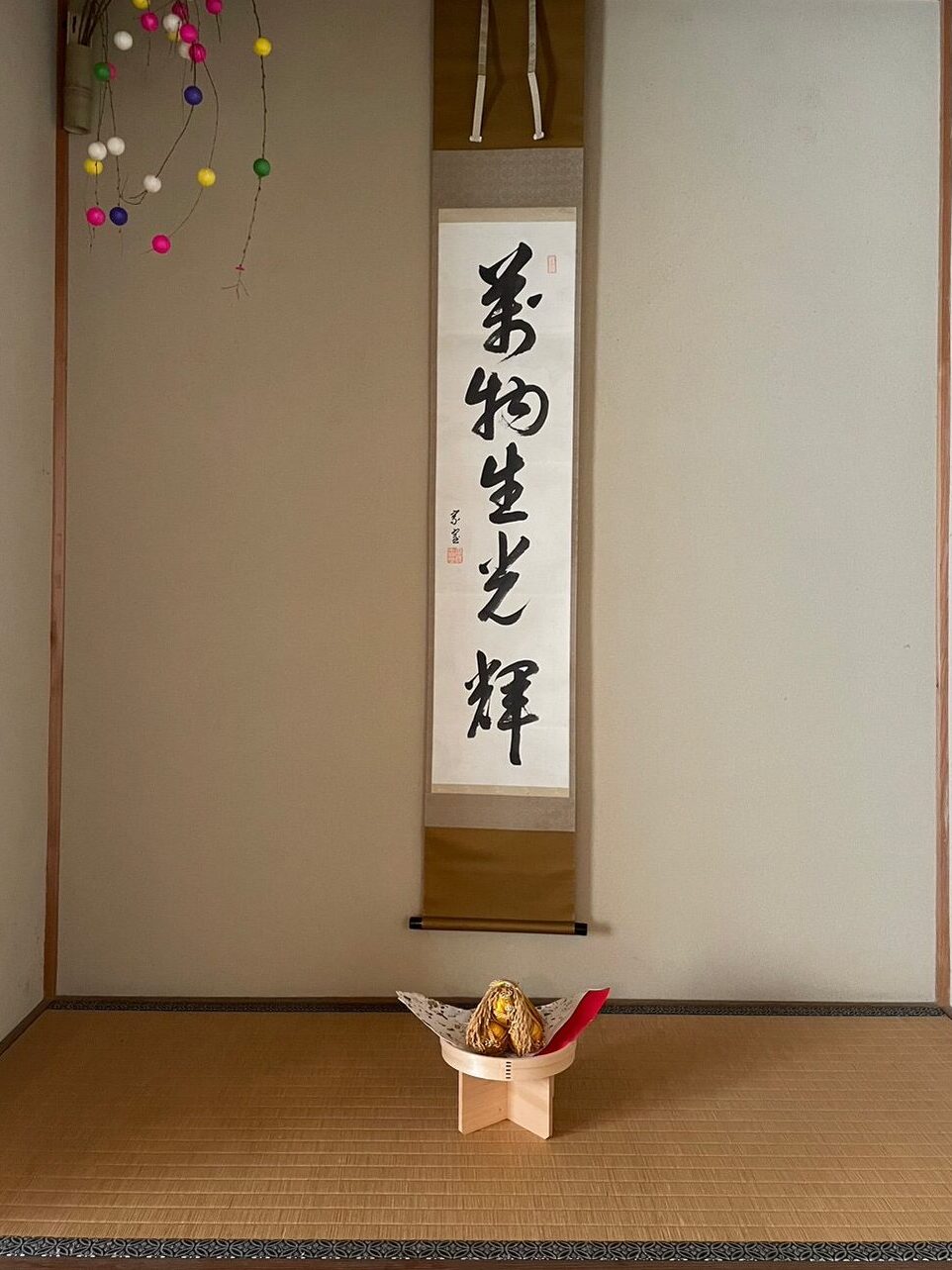茶道のお稽古やお茶会に参加すると、茶室の一角に掛け軸や花が飾られているスペースがあることに気づくと思います。
それが「床間(とこま)」と呼ばれる、茶室にとってとても大切な場所です。
でも、「床間って何のためにあるの?」「どうしてこんなに大事にされているの?」と思ったことはありませんか?
今回は、茶室の床間の役割や意味について、初心者にもわかりやすくご紹介します!
床間とは?
床間とは、茶室の中で最も格式の高い特別な空間のことを指します。
ここには主に掛け軸、茶花(ちゃばな)、香炉などが飾られ、お茶席の雰囲気を作り出します。
床間は単なる飾りではなく、お茶席において亭主(ていしゅ)が客人をもてなす心を表す場所なのです。
床間の3つの役割
① その日のテーマを伝える
→ 掛け軸には、その日のお茶会のテーマや亭主の心を映す言葉が書かれています。
→ 例えば、「和敬清寂(わけいせいじゃく)」という禅の言葉が掛かっていれば、茶道の精神を大切にする席であることがわかります。
② 季節を感じる
→ 床間には、その時期の**茶花(ちゃばな)**が生けられます。
→ 春なら桜、秋なら紅葉など、自然の移ろいを大切にするのが茶道の美学です。
③ 心を落ち着ける空間
→ 茶室に入ったら、まず床間を拝見するのが基本の作法です。
→ 掛け軸の言葉や、花の美しさを静かに味わうことで、心が落ち着き、お茶席の雰囲気に溶け込むことができます。
茶室の床間の楽しみ方
1. 掛け軸の言葉を読んでみる
→ 難しい言葉が書かれていることもありますが、意味を知ると、亭主の想いが伝わってきます。
2. 花の種類を観察する
→ どんな花が飾られているのかを見て、季節の移り変わりを感じてみましょう。
3. 静かに床間を眺め、心を整える
→ 茶道では、「見る」こともおもてなしを受ける大切な作法です。
→ まずはゆっくりと床間を拝見し、心を落ち着けてからお茶をいただくと、より豊かな時間になります。
まとめ
床間は、茶室において単なる飾りではなく、その日のテーマや季節感、亭主のもてなしの心を映し出す大切な空間です。
お茶会やお稽古に行く機会があれば、ぜひ床間に注目してみてください。
掛け軸の言葉や茶花の美しさを味わうことで、お茶席がさらに特別なものになるはずです。
茶室に足を踏み入れたら、まずは床間をじっくり眺める——
それだけで、より深く茶道を楽しめるようになりますよ!
The Role of Tokonoma in a Tea Room
If you have ever attended a tea gathering, you may have noticed a special alcove in the tea room where a hanging scroll and flowers are displayed.
This space is called the “Tokonoma”, and it plays a very important role in the Way of Tea.
But have you ever wondered, “Why is this space so important?”
In this article, we will explore the role of Tokonoma and its deep meaning in the tea ceremony!
What is Tokonoma?
Tokonoma is the most prestigious space in a tea room, where a hanging scroll (kakemono), seasonal flowers, and sometimes incense burners are placed.
However, it is not just for decoration—it is a space where the host expresses respect and hospitality to the guests.
The Three Roles of Tokonoma
① It Sets the Theme of the Gathering
→ The hanging scroll often contains Zen phrases or poetic words that reflect the theme of the tea gathering.
→ For example, the phrase “Wa-Kei-Sei-Jaku” (harmony, respect, purity, and tranquility) represents the fundamental spirit of tea.
② It Reflects the Season
→ The flowers in the Tokonoma, known as “chabana” (tea flowers), are carefully selected to represent the current season.
→ Cherry blossoms in spring, maple leaves in autumn—each element in the Tokonoma helps the guests feel the passage of time.
③ It Creates a Space for Mindfulness
→ Upon entering the tea room, guests first admire the Tokonoma in silence.
→ Observing the beauty of the scroll and flowers allows them to mentally transition into the world of tea and appreciate the host’s thoughtfulness.
How to Appreciate Tokonoma
1. Read the Words on the Scroll
→ Some phrases may be difficult to understand, but learning their meaning helps you connect with the tea gathering’s theme.
2. Observe the Flowers
→ Pay attention to the types of flowers displayed and enjoy how they reflect the season.
3. Take a Moment of Silence
→ In the tea ceremony, “seeing” is also part of the etiquette.
→ By quietly appreciating the Tokonoma before drinking tea, you can immerse yourself more deeply in the experience.
Conclusion
Tokonoma is not just a decorative alcove—it is a window into the heart of the host, reflecting the theme of the gathering, the beauty of the season, and the spirit of hospitality.
Next time you enter a tea room, take a moment to admire the Tokonoma.
By appreciating the words on the scroll and the simplicity of the flowers, you will gain a deeper understanding of the tea ceremony.
Simply taking a quiet moment to observe the Tokonoma can elevate your tea experience—try it and see how it enriches your appreciation of this beautiful tradition!



